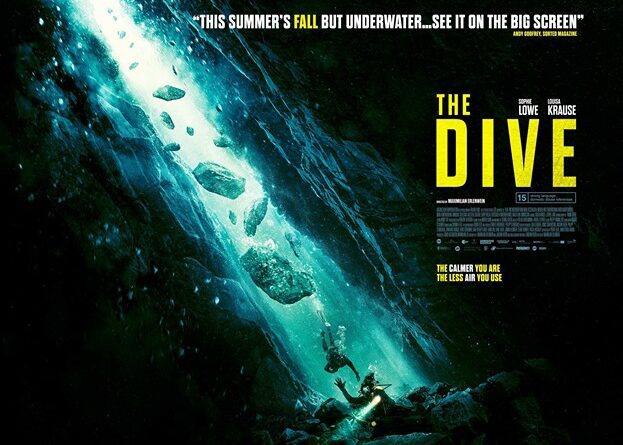“The Dive”: Is The Underwater Surviving Film Worth Diving Into? | Review
I like survival films about man versus nature (and sometimes other dangers). They tend to be tense, plus the stressful situations they depict make them horror films, even if there is almost no blood or gore. In recent years, we have seen quite a few movies in which this struggle takes place underwater, preferably at a depth of several dozen meters, with the characters stuck to their place and trying to find salvation against all odds.
In this respect, “The Dive” follows a fairly common concept, even though it is too familiar. It is enjoyable and primarily thrilling, although it feels like it has run out of cards at some point. We got a film which was shown in cinemas briefly, but it is mainly suitable for casual home viewing.
The Dive Plot: Nothing New Under The Water
Not long ago, we reviewed the “47 Meters Down” films here on the site, which presents a story very similar to “The Dive”: two sisters (or a larger group of young women in the sequel) who dive into the sea and find themselves trapped in a shark cage, a tunnel built by the Mayan tribe or whatever it may be in the third film, which will arrive sometime in the future.
This concept resembles films with unfortunate characters stuck at the other end of the scale, high above the ground. In the surprising “Fall” (2022), for example, two friends get stuck on an abandoned communications tower, and at a certain point, the viewer (meaning me) shares their fear of heights. In this case, also, two more sequels are expected in the future.
These choices, in my opinion, are not accidental: In fact, in the poster of “The Dive,” there is a comparison to “Fall” (“This summer’s fall, but underwater…”). There is something about this narrative that works: the struggle against time and other troubles, the feeling of helplessness, the specific fear that the viewer shares, the lack of a human factor who can provide rescue, and so on. “The Dive” is not original in its most basic narrative structure. Two sisters go on their annual diving trip to an unknown destination (most of the film was shot in Malta). Already during the opening scene, we understand that they are pretty distant and that there is a certain tension between them, mainly around the fact that one of them has left home and is apparently in conflict with their mother.
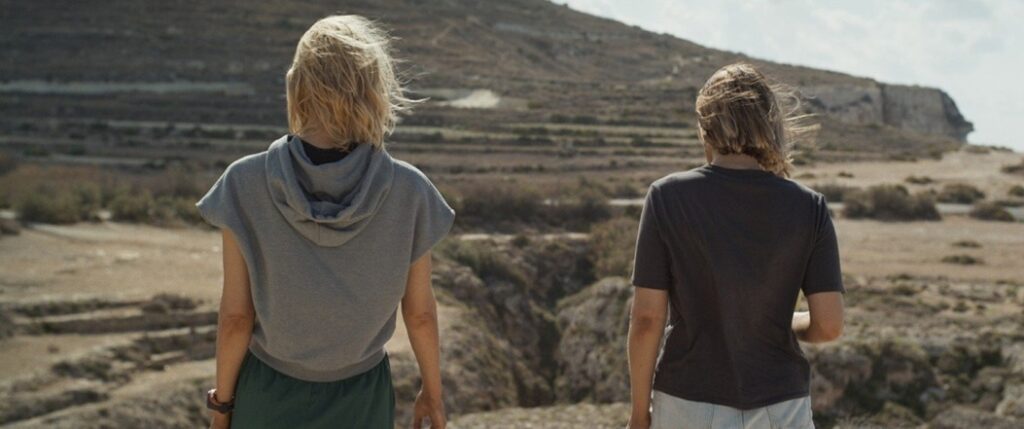
Like some of the films we mentioned, the sisters in “The Dive” are quite opposites. May (Louisa Krause, “Maggie Moore(s),” “Dark Waters” and Steven Soderbergh’s drama series “The Girlfriend Experience”) is the older and more measured sister of the two, a stern and calculating girl who lacks a bit of joy in life, at least on the outside. The younger Drew (Sophie Lowe, “Once Upon a Time in Wonderland,” “Pretty Little Liars”) is a bit more passionate and driven by emotion.
During the dive, a rockfall suddenly occurs. May finds herself trapped under a rock several dozen meters underwater. The problem is that there is little time to waste underwater at such a depth. It is clear to the viewer that she does not have 127 hours to wait, like in the excellent film “127 Hours” with James Franco (which is based on a true story). During the movie, I wondered if the solution to the situation would be to amputate the poor girl’s lower body, but to my delight (or disappointment, as a horror fan), that didn’t happen.
Here is the trailer of “The Dive”:
💀 Killer Deals & Scary Recommendations 💀
🎭 Costumes & Accessories
HalloweenCostumes Fun Costumes Entertainment Earth
🛒 Online Shopping
AliExpress Amazon Walmart Etsy
🧛 Collectibles & Horror Brands
Funko Hot Topic Lego Spirit Halloween
🎢 Attractions & Tours
GetYourGuide Tiqets Viator Klook
📖 Blogs & Horror Sites
Bloody Disgusting iHorror Fangoria
🩸 Disclaimer: Some links are affiliate links. The price stays the same – it just helps keep the site alive 👻
There Are Rescue Instructions, But They’re Hard To Follow
The solution to escape lies with the young sister Draw, who, quite unusually in films of this type, can go down to the ground and try to find solutions. May sends her a detailed list of instructions, including life-saving instructions and probably a shopping list for the nearest supermarket. She has to, within a very short time, find gas cylinders, call for help, get a jack (backup) from the rented car to lift the rock, and probably a few other things I missed, like buying a cake for the weekend or making her coffee with soy milk, extract on the side, with sugar and cinnamon. These tasks can buy the trapped sister some time until a more significant rescue arrives, whether by a human or when Drew finds a way to get her away from the rock that threatens to crush her.
The problem is that we are in a survival movie, and it is clear from the beginning that nothing will be straightforward here. A rockfall will prevent access to the phone, which in any case would not have been effective in a movie of this type (it is a pity no one filmed a romantic comedy at the same time in this beautiful location, because then the heroine might have had access to a cell phone). Then the car keys are gone, there is no Jack in its trunk, the boat passing nearby does not hear the nurse’s cries, and the house that appears on the map is empty.
Drew tries to do almost everything in a fight against time, but as these attempts fail – because it is impossible to solve the problem in the first or second third of the film – she begins to despair. Will she be able to find the strength and peace of mind to save her sister or to prevent herself from further trouble?
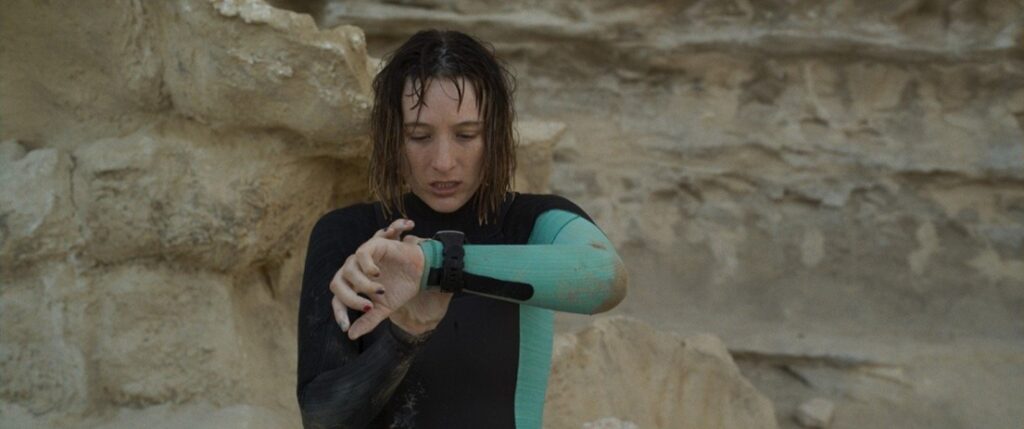
The Main Enemy In The Dive: The Clock
“The Dive” is a project made in international territorial waters, if you can call it that. It is a German-Maltese production headed by German director Maximilian Erlenwein in his third film. Erlenwein wrote the script together with the Swedish Joachim Heden, who wrote and directed the 2020 Norwegian film “Breaking Surface,” of which the current film is a remake. Haden, incidentally, also directed the mediocre “The Last Breath” from 2024, about a group of former college friends who go on a diving trip in the Caribbean, explore an abandoned ship from World War II, and find themselves trapped deep underwater surrounded by bloodthirsty sharks that will probably make some of them take their last breaths.
We’ve become accustomed to seeing underwater survival films that pit the protagonists against a thousand and one dangers at once, perhaps out of a desire to increase the viewers’ level of anxiety: sharks and other malicious creatures, drowning, storms, suffocation, stupid supporting characters, and so on. In most cases, these additions are unnecessary because they damage the sense of tension. After all, it makes the film too “messy.” In my opinion, films that present one central danger that becomes more tangible as time passes can be more effective.
So, in “The Dive,” there are no sharks and not really any blood, but there is another enemy. “The Dive” presents the characters in a fight against time, which becomes the main villain here. In a reasonably practical narrative structure that reminded me mostly of thrillers (like “Out of Time” with Denzel Washington from 2003), the film presents one broad situation of a journey against time, divided into several more specific sequences or scenes of a battle against the ticking clock.
Sometimes, you can even see a timer on the screen that shows how much time we have until the gong. Suddenly, our hero has to do something in 20 minutes. Then, she will have other tasks to perform in a different period. At the same time, the feeling is that every such obstacle also brings us closer to the general danger because oxygen will end sometimes. During the film, I found myself trying to calculate how much time she has if she gets all the oxygen cylinders that are supposed to be there somewhere. Still, I stopped after realizing that this calculation was complicated for me.
More generally, without mathematical calculations, we can say that “The Dive” does an adequate job. Most of these “races” against time manage to be tense, even if, at some point, it feels like the concept is repeating itself and the film loses momentum. During these scenes, we learn about the heroine’s attempts to deal with the situation and function rationally, which works because she is brighter than the average girl in a survival film.

Many Moments Of Madness
Usually, in films of this type, we mock stupid and illogical decisions, but in this case, both characters remain more or less clear-headed during the dive. May, stuck under a rock 28 meters below sea level for most of the film, tries to stay focused and calm without overthinking, assuming that this way, the loss of oxygen will be slower.
Despite this, she explained to her little sister precisely what she needed to do, with instructions that even I, during the carefree sitting on the couch, was sure there was no way I could remember. At one point, I thought about stopping the film and opening Notes on my phone to write down the instructions, but then I decided that would be too stupid since the movie was already filmed and edited.
Unsurprisingly, Drew forgets a few things and makes mistakes, some of which seem like script shortcuts – say, we mean dropping a gas balloon into the water – but still shows creativity and correct thinking most of the time. She faces dilemmas related to the fight against time, mainly choosing between several rescue attempts and maneuvers between them at an impressive pace. After all, she manages to enter an abandoned building by climbing a bicycle, writing rescue instructions on a map for anyone who comes across them (and no one does), and even rolling a car off a cliff without moving it to open the locked trunk of her car, which automatically made me get up from the couch and shout “But wait, is there insurance with a deductible waiver for cars?” (we don’t get the answer for this critical question, by the way).
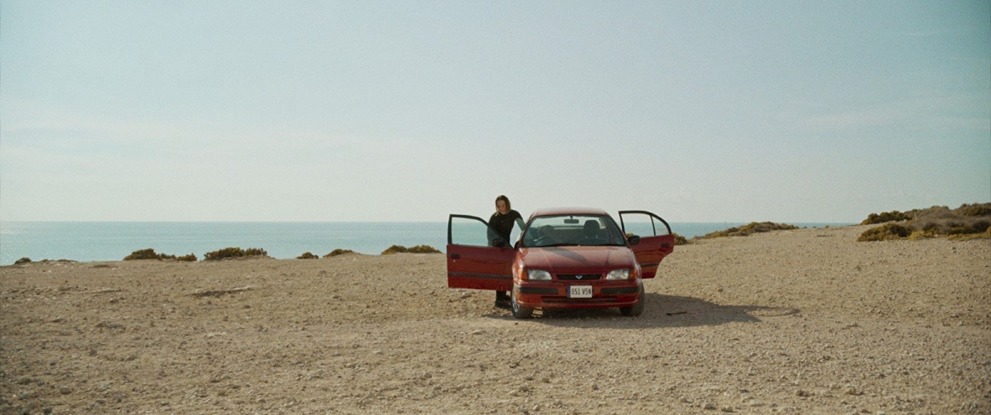
What Makes The Dive Dangerous? Ask The Characters
Look, I’m far from a diving expert. You can count the number of times I’ve dived or snorkeled. For example, I remember diving with sharks at the Dolphin Reef when I was a child, and another “dive” with a snorkel in Koh Tao in Thailand, in the Blue Lagoon in Malta, and maybe one or two other dives that have blossomed from my memory. I’m not writing this because it interests anyone, certainly not in the current context. Instead, there were cases in which I felt that “The Dive” takes our knowledge of diving for granted, or if you will – the reasons that make it dangerous. For a “Dive Virgins” (almost!) like me, it was a problem.
What do I mean? In some cases, the characters panickedly describe various situations during the dive, which should be clear to someone with some field knowledge. I, for example, did not understand at first what the “Decompression stop” mentioned in the film about 30 times was and whether you had to use A GPS to find it, what the changes in nitrogen levels compared to oxygen levels meant, or whether deep-sea intoxication was related to drinking alcohol underwater or simply described some other danger of diving.
Indeed, the film doesn’t have to spoon-feed us these terms with unnecessary explanations that seem meant for 14-year-old viewers. Still, in some cases, I got the impression that I was a little “out of the picture” and that perhaps I would have been more anxious about the fate of the characters if I understood what they were supposed to be feeling and what the danger was at any given point. I felt like in an episode of “House,” where Dr. House and the team bombard the viewer with medical terms, conditions, and symptoms. The viewer who doesn’t understand much about medicine simplifies them to thoughts like “Okay, so that’s good,” or “Damn, that medical term with that complicated foreign name sounds dangerous.”
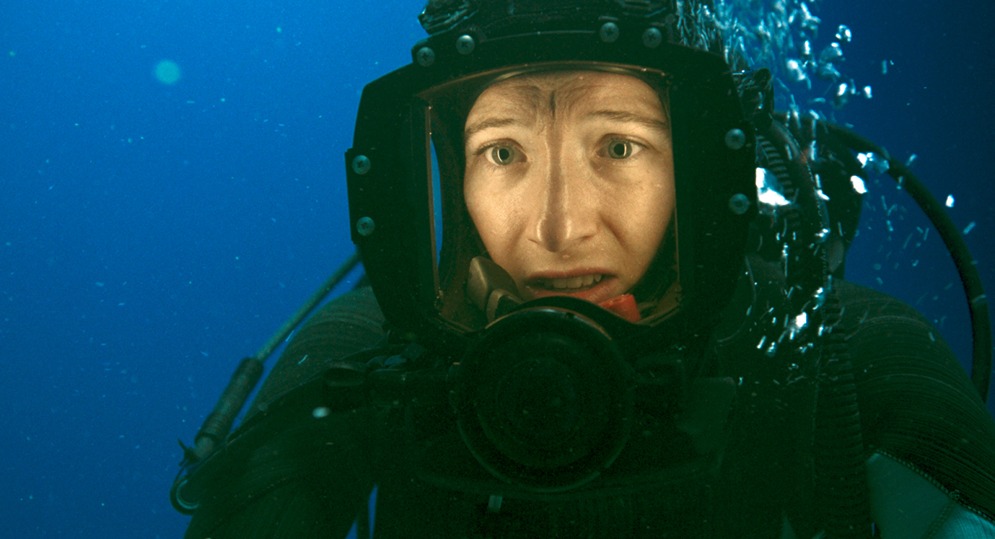
Identification with the characters is one of the keywords in survival films, and the filmmakers can create it in several ways. In some of them, “The Dive” does the trick. The underwater shots are excellent in some ways, and even more importantly, they convey anxiety and claustrophobia. Above the water, the choice of long shots (some from a drone) is correct and causes a feeling of helplessness. Ostensibly, the character is above the water when, at any moment, someone could emerge to save her, but in reality, this does not happen, and the cinematography emphasizes this. The soundtrack, which also comes into play when we have difficulty seeing what is underwater, also contributes to the tension.
The film struggles with other elements, the success of which would have made it much better. First of all, the dialogues here are, in some cases, a bit superficial and trite. There is almost no development of the characters because we know almost nothing about the sisters. There are flashbacks here and there from a childhood experience, which show a bit of the family story (the connection to diving) and the disconnect between the sisters. Still, it is difficult to say that they contributed too much to the film, and it was possible to do without them.
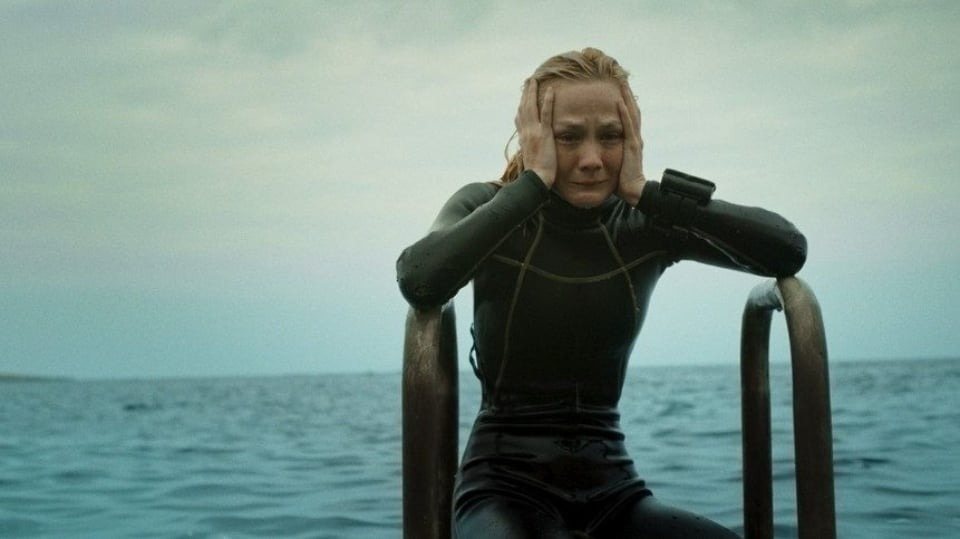
Should You Watch The Dive?
“The Dive” is a primarily successful film, which sometimes stretches the viewer to the limit. It presents intelligent characters, more or less, who deal with difficulties that characterize underwater survival films and survival films against nature in general. The viewing experience here is undoubtedly positive, but it could have been more complete if the film had taken a few risks. The feeling is that, despite being well-made in most respects, it is routine and has difficulty taking steps to connect the viewer more closely to the situation or the characters.
“The Dive” may add a few new fears to your rather long list, perhaps related to terms that are probably important to divers. Luckily, I don’t dive.
The Dive – Everything You Need to Know
Year: 2024
Director: Maximilian Erlenwein
Cast: Louisa Krause, Sophie Lowe
Screenplay: Maximilian Erlenwein, Joachim Heden
Running time: 91 minutes
Country of production: Germany, Belgium, United Kingdom, Malta, France
Language: English
Release Date: August 24, 2024
Ratings:
IMDB: 5.6
Rotten Tomatoes: 67%

